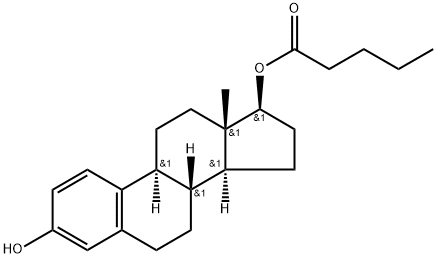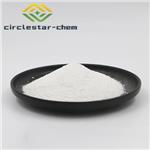
Estradiol valerate
- Product NameEstradiol valerate
- CAS979-32-8
- CBNumberCB0300193
- MFC23H32O3
- MW356.51
- EINECS213-559-2
- MDL NumberMFCD00056541
- MOL File979-32-8.mol
Chemical Properties
| Melting point | 144°C |
| Boiling point | 438.83°C (rough estimate) |
| Density | 1.1024 (rough estimate) |
| refractive index | 1.4700 (estimate) |
| storage temp. | Sealed in dry,Room Temperature |
| solubility | Practically insoluble in water, soluble in alcohol. |
| pka | 10.25±0.60(Predicted) |
| form | Solid |
| color | White to off-white |
| biological source | synthetic |
| Merck | 13,3738 |
| BRN | 2480357 |
| InChI | InChI=1/C23H32O3/c1-3-4-5-22(25)26-21-11-10-20-19-8-6-15-14-16(24)7-9-17(15)18(19)12-13-23(20,21)2/h7,9,14,18-21,24H,3-6,8,10-13H2,1-2H3/t18-,19-,20+,21+,23+/s3 |
| InChIKey | RSEPBGGWRJCQGY-RBRWEJTLSA-N |
| SMILES | C[C@]12CC[C@]3([H])C4C=CC(O)=CC=4CC[C@@]3([H])[C@]1([H])CC[C@@H]2OC(=O)CCCC |&1:1,4,15,17,21,r| |
| CAS DataBase Reference | 979-32-8(CAS DataBase Reference) |
| FDA UNII | OKG364O896 |
| NCI Drug Dictionary | estradiol valerate |
Safety
| Symbol(GHS) |
 
|
|||||||||
| Signal word | Warning | |||||||||
| Hazard statements | H351-H361fd-H362-H410 | |||||||||
| Precautionary statements | P202-P260-P263-P264-P273-P308+P313 | |||||||||
| Hazard Codes | T | |||||||||
| Risk Statements | 60-61 | |||||||||
| Safety Statements | 53-45 | |||||||||
| WGK Germany | 3 | |||||||||
| RTECS | KG5793000 | |||||||||
| HS Code | 29372390 | |||||||||
| NFPA 704: |
|


